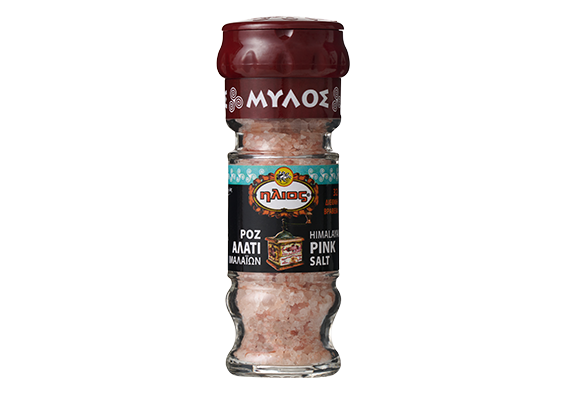

The Pink Rock Himalayan Salt is one of the most famous rock salts in the world and is known as “white gold”. It is a pure, natural, crystallized salt, of a superior crystallized structure, which has trapped small particles easily metabolized by the human organism. The many hues of pink, red and white color suggest the presence of rich and various minerals and energy-rich iron in this salt.

Vegetarian

Gluten Free

Vegan
| Mill | 80gr |
|---|
It is suitable for red meat, and enhances the taste of smoothies and green juices. It brings out the flavor of salads and dishes with pasta. Pink salt can be used both as brine and table salt.
The Himalayan mountain range extends throughout Asia traveling through China, Nepal, Myanmar, Pakistan, Bhutan, Afghanistan and India. Most people associate the Himalayas with Mount Everest, the highest peak on this planet, but now we have something else to think about – salt.
Once upon a time (some millions of years ago), salt lakes with sea salt, now lying deep within the Himalayas, were covered by lava. Besides being kept in a clean environment surrounded by snow and ice all year round, the lava is believed to have protected the salt from the modern-say pollution. This reasoning results in the belief that the Himalayan Pink Salt is the purest salt in the world. It is hand-mined from the mountains to reach our kitchens.
The Himalayan Salt contains the same 84 trace minerals and elements found in the human body. That alone is really impressive! Some of these minerals are: sodium chloride, sulphate, calcium, potassium and magnesium. When we consume this salt, we take less sodium per serving than the regular take salt, because it is less refined and its grains are larger. Therefore, the Himalayan Salt has less sodium per serving, because the crystals or the flakes take up less space than the highly processed table salt.
One more thing important when it comes to this salt is that, because of its unique cellular structure, it stores vibrational energy. The minerals in this salt exist in colloidal form, which means that they are small enough to be easily absorbed by our cells.